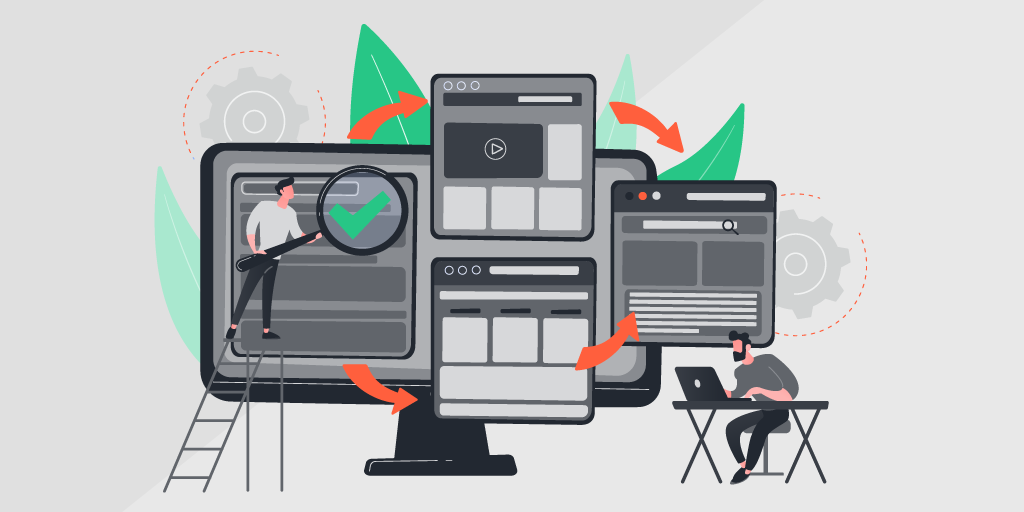
Managing Rapid Change in an Increasingly Digital World
Change is the one constant in the world of Technology. Over the past few years, a tremendous amount of change has forced organizations in every industry and sector to re-evaluate their technology investments and the ways in which they manage technology across the enterprise. The pandemic was a catalyst for technological change: 93% of businesses surveyed by McKinsey shifted to remote work, 62% reported increasing customer demand for online services, and 34% said they needed to migrate company’s assets to the cloud. As a result, IDC predicts that direct investments in digital transformation between 2020 and 2023 will reach $6.8 trillion.
Over the last decade, as organizations adopted new technologies and implemented the infrastructure to support them, IT teams needed formal processes for taking inventory of IT assets, deploying new ones, maintaining and upgrading them, then disposing of them when the time came. The practice of IT Asset Management (ITAM) emerged from this need, and in 2011, Gartner defined ITAM as “a framework and set of processes for strategically tracking and managing the financial, physical, licensing and contractual aspects of IT assets through their lifecycle.”
Fast forward to the past few years: the need to manage an expanding array of IT assets intensified, and industry regulations and frameworks such as NIST, CIS and others proliferated. ITAM was still a mostly manual, time-consuming process, involving hours of labor and spreadsheet maintenance. As the IT Estate grew, these processes were no longer sufficient. Lansweeper developed the leading automated solution for scanning, discovering and recognizing any and all IT assets across an organization, enabling teams to create and maintain a complete and accurate IT asset inventory – without the spreadsheets. By eliminating the need to manually track, define and log IT assets across the organization, Lansweeper enabled SysAdmins to be much more effective and productive.
But as the world of business has evolved, so must ITAM. Today, physical IT assets are just part of the story for IT teams. In this increasingly digital world, their purview has expanded to include both physical and virtual IT assets, Internet of Things (IoT) and Operational Technology (OT). As trends like digital transformation, cloud, automation and the hybrid workplace converge, modern organizations require a vast number of physical and virtual IT assets – from servers and routers, to desktop and mobile devices, virtual machines, containers, IoT, OT and many types of software – to operate efficiently and effectively:
- 25% of organizations have adopted large-scale cloud-distributed technology.
- 60% of executives say IoT will play a critical role in their digital business strategy.
- The global market for OT reached $34.2 billion in 2020 and is projected to grow at a CAGR of 5.3% to $49.1 Billion by 2027 .
As such, the way in which we manage and govern our technology assets must now evolve to accommodate this fast-paced, ever-changing business environment. Modern IT organizations must:
- Implement proper cybersecurity strategies and protocols
- Manage hardware and software configurations
- Run an efficient and useful IT service desk
- Execute cloud migration projects
- Efficiently share data across teams and functions
- Optimize IT costs and maximum the ROI of technology assets
To accomplish all of these mission-critical responsibilities, organizations need Technology Asset Intelligence.
As a result of the pandemic, 60% of North America’s products and services are now fully or partially digitized.
– McKinsey
What is Technology Asset Intelligence?
Technology Asset Intelligence (TAI) uplevels the practice of ITAM to acknowledge just how pervasive and critical technology has become – from the physical and virtual infrastructure that serves as the backbone for our data and services, to the software that enables us to access those data and services, to the IoT and OT in remote locations and on the manufacturing floor. More than just managing IT and software assets, TAI is the process of deriving actionable intelligence from the data generated by every physical, virtual and software asset an organization owns, along with information about all users in the organizations – intelligence that can be applied to support various business use cases.
TAI serves as a foundation for making informed decisions about how organizations tackle digital transformation initiatives, manage and optimize their growing infrastructure, and structure and enhance the customer experience. And, it begins with an indisputable, comprehensive system of record that contains all the information necessary to answer any question about a company’s technology ecosystem.
38% of executives plan to invest more in technology to make it their competitive advantage.
– McKinsey
Any Business or IT Scenario – One Source of Truth
Lansweeper began as a small startup with a solution to help IT SysAdmins. After almost ten years of rapid growth, we are now a global team with solutions for IT teams, cloud teams, DevOps, ISVs, telcos and consumers. As we continue to partner with market leaders and acquire new technology, we are broadening our vision and corporate mission in a way that connects our history with our present purpose and our future potential as an organization: to be the indisputable leader in Technology Asset Management.
Lansweeper started with a focus on inventory of physical IT assets, but today’s definition of technology assets is much more expansive, encompassing a wide array of physical and virtual assets. While we will always be focused on managing technology assets, and our traditional audience of SysAdmins will remain core to our identity, the Lansweeper platform has become relevant to any audience that deals with and is impacted by technology, providing a reliable data source for the world of technology at large.
Lansweeper ushered in the concept of ITAM 2.0, which turned the process of creating asset inventories on its head, providing accuracy, breadth and depth and the ability to leverage IT asset data for a full range of use cases — cybersecurity, cloud migration, helpdesk, compliance and more. Solutions that specialize in those use cases are then layered on top, and draw from the data layer that acts as the foundation. Operating in alignment with ITAM 2.0, our platform abstracts the data layer to ensure consistency, accuracy and completeness, eliminating operational overhead and complexity, while improving the quality of the data.
Lansweeper discovers & aggregates data across the IT stack, so that organizations can tap into an always-accurate single source of truth to inform all business and IT scenarios and enable strategic decision-making. It provides a single system of record to feed conversations and decisions, and provide other mission-critical systems – such as CMDB, ITSM, SIEM and SOAR systems – automatic and immediate access to complete, up-to-date, granular IT asset data, eliminating silos while empowering various teams to act quickly.
Download our visionary white paper where we explore Lansweeper’s ITAM 2.0 concept in depth, and explain how to create an IT asset system of record that can be leveraged across multiple scenarios to support any IT use case or business goal — SAM, helpdesk, license management, cloud migration, cybersecurity and more — with accurate and always up-to-date asset data.
ITAM: The Foundation for Efficient IT Management
Learn why Lansweeper is used by thousands of enterprises worldwide.u200b
Get the WhitepaperLansweeper bridges the gap between simply discovering and logging IT assets to acknowledge the broader application of technology data across an organization. It empowers organizations with Technology Asset Intelligence so they can leverage actionable data and insights to optimize their infrastructure and derive maximum value from their technology investments.
“We can no longer limit IT asset management to physical devices. We must provide actionable intelligence across all technology assets – from physical and virtual devices, to software and cloud assets, to IoT and OT. By doing so, we help our customers continue to build the foundation for managing technology effectively across the organization, to accommodate and support technology innovations and expansion.”
Roel Decneut, CMO, Lansweeper
How Lansweeper Provides Technology Asset Intelligence
With its market-leading technology asset discovery and recognition technologies, combined with advanced asset intelligence and an expanding solutions ecosystem, Lansweeper delivers on the promise of Technology Asset Intelligence:
- Automated and Instant IT Asset Discovery: At the core of our platform is IT asset discovery and recognition, and the ability to create a complete and accurate IT asset inventory. Lansweeper combines active and passive agentless and agent-based scanning with data aggregation for unprecedented visibility across the IT estate. The solution locates and identifies devices both inside and outside the four walls of a business, in hard-to-reach places and from unexpected sources – all Windows, Linux and Mac devices as well as routers, printers, switches, ports, virtual computers and mobile devices. Using Asset Radar, Lansweeper detects assets the moment they connect to the network, however briefly. Lansweeper’s AI-powered Credential-free Device Recognition (CDR) technology enriches IT asset data with additional information that previously could not be retrieved without credentials – such as device manufacturer, model and operating system.
- Asset Intelligence. With a single source of truth of data on every physical and virtual technology asset, Lansweeper enables deep and actionable, domain-specific business intelligence to inform technology investments and strategies, and help organizations run more efficiently, securely and cost-effectively. In short, we highlight the data that’s important to help teams understand the unknown unknowns. Lansweeper organizes and contextualizes the data it collects according to an organization’s projects and processes, making it usable and actionable for a variety of business scenarios. Users can visualize and analyze all data via pre-built and customizable dashboards and widgets to understand patch status, vulnerability exposure, security compliance, software licensing, hardware warranty information, and much more. Advanced reporting features enable teams to retrieve and analyze the data they need when they need it, and easily share that data with stakeholders.
- Solution Ecosystem: Through our partnerships, Lansweeper seamlessly connects to operational systems across an organization’s technology stack, including CMDB, ITSM, SIEM, SOAR and more, providing instant access to data and insights relevant for a broad range of IT use cases. It enables teams to fuel any IT scenario through a federated and centrally managed Asset Inventory. An extensive and growing library of APIs enable customers and partners to leverage Lansweeper data to derive their own unique insights, and we’re focused on expanding our partner ecosystem with strategic investments in integrations, as well.
Business Intelligence: The application of TAI goes beyond technology management and optimization within a single organization. By aggregating, anonymizing and externalizing IT Asset data, organizations can deliver broader industry insights to help guide strategic decision-making at the executive level.
“Lansweeper wants to become the clearinghouse for all data on technology assets, including its users. With access to complete, accurate Lansweeper data, organizations can drive decisions – large or small, transactional and strategic.”
Roel Decneut, CMO, Lansweeper
Lansweeper Extends TAI to Cloud Environments
Lansweeper is making strategic investments that support the realization of our mission to provide Technology Asset Intelligence. In 2020, Lansweeper acquired Fing, the leader in AI-driven device recognition and fingerprinting identification technologies, and more recently the acquisition of Montreal-based UMAknow and its Cloudockit solution will extend and enhance Lansweeper’s capabilities with cloud discovery and documentation, helping organizations understand their cloud environments and identify misconfigurations and potential security threats. UMAknow‘ s Cloudockit technology automatically generates architecture diagrams and technical documentation of an organizations’ cloud environments to support many scenarios.
„Hybrid IT environments are the new normal, so extending our product offering with the unique capabilities in Cloudockit makes perfect sense. We have been very impressed with the quality of the product this team has created and we look forward to what we can accomplish together.“
– Dave Goossens, CEO at Lansweeper
Introducing Lansweeper Cloud
With a long list of powerful new features, our Lansweeper 2022 Spring Launch delivers on the promise of Technology Asset Intelligence, enabling organizations to derive actionable intelligence from every physical, virtual and software asset across the technology estate.
Our new release adds capabilities to simplify the process of creating a complete and accurate technology asset inventory while enabling you to collect more information about Windows and Linux assets than ever.
Lansweeper Cloud extends our industry-leading Asset Discovery Software with a modern, cloud-based interface. With Cloud, we build on our best-in-class discovery by enabling data federation and API-based integrations to support multiple IT scenarios throughout your organization.
Built for Global Organizations to Fuel Any IT Scenario
The Enterprise-grade Platformnfor Managing Technology Asset Data in 1 Place
Learn MoreIntelligence to Fuel the Future of IT
In terms of technology adoption, there’s no going back. The future of business will be characterized by digital technologies, hybrid work environments, cloud-based services and infrastructure, and continuous change. Organizations that have access to Technology Asset Intelligence will have a competitive edge, with the ability to effectively manage the expansion, cost and security of a growing and increasingly diverse IT estate, and make informed strategic decisions to optimize IT investments and maximize their positive impact.
Lansweeper is the undisputed leader in Technology Asset Intelligence, enabling organizations to make data-driven decisions about their technology asset estate.
 Roel Decneut, CMO, Lansweeper
Roel Decneut, CMO, Lansweeper  – Dave Goossens, CEO at Lansweeper
– Dave Goossens, CEO at Lansweeper